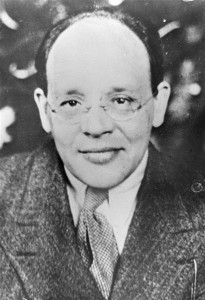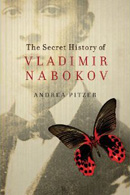Isaac Babel and Vladimir Nabokov
Russian author Isaac Babel is reported to have said of his literary contemporary Vladimir Nabokov that “he can write, but he’s got nothing to say.” Early in his career, Babel wrote a short story just three pages long called “Line and Color.” This story goes to the heart of the tension between invention and reality in art, and oddly enough, also explains how it is that readers like Babel have missed part of what Nabokov was up to.
Born five years apart in pre-Revolutionary Russia, Babel and Nabokov both became extraordinary stylists. Their fiction was condemned as obscene. Nabokov was known for his escapes, both literary and literal. Babel, also celebrated for his vivid, poetic images, found his luck less dependable in the real world.

Babel’s experiences in the First World War and then the Russian Civil War spurred the the creation of his first timeless characters in legendary stories that made his name, even as they made him enemies. He found recognition and built a place for himself in the early Soviet literary establishment, but it was for many reasons a precarious situation.
Trotsky and Kerensky
Babel’s “Line and Color” pulls in two real-world characters—Alexander Kerensky and Leon Trotsky—who also appear in The Secret History. The story recounts a meeting between the narrator and Kerensky in December 1916, just two months before revolution would force the Tsar to abdicate. In the real world, in the months following the time and place in which the story is set, Kerensky rose to become a Minister and then, eventually, Prime Minister in the series of Provisional Governments that briefly ruled Russia before the Bolshevik takeover in October 1917.*
In Babel’s story, the narrator has a meal with Kerensky just outside Helsinki, Finland. The description of the meal is concise but charged with images of decadence and collapse. Just after a sighting a beautiful countess who recalls Marie Antoinette, the narrator watches Kerensky eat three pieces of cake.
After the meal, the narrator and Kerensky stroll through a forest bejeweled with ice. On their walk the narrator comes to realize that Kerensky is nearsighted and unable to recognize people and things around him. Confronted by his companion, Kerensky not only admits to having impaired vision, he insists that he will never wear spectacles.
Kerensky explains that his nearsightedness allows him free rein to reconstruct his surroundings in enchanting forms without being bound to the hard edges of the real world. “You can keep that line of yours, with its repulsive reality,” he says. “You are living the sordid life of a trigonometry teacher, while I am enveloped by wonders…”
The story jumps to some months after the Tsar’s abdication, in the midst of strikes and unrest. Now Supreme Commander of the Russian Army, Kerensky approaches a podium to speak to the crowd and remains “the only spectator without opera glasses.” After he finishes, Leon Trotsky, whose spectacles are so well-known Babel does not even need to mention them, steps up to address the crowd. The beginning of his speech provides the last line of the story: “Comrades and Brothers!”
In that moment Trotsky is not a Bolshevik; he has not yet fully joined Lenin. But after the story ends, re-entering the stream of real history, perhaps no one will do more to ensure Kerensky’s fall and flight from Russia. Trotsky, leading the second Bolshevik attempt to take over the government, will succeed. He will go on to take Kerensky’s place, commanding an army to victory, this time in a civil war.
Any reader aware of the events that follow the story knows Babel is making clear that Kerensky’s nearsightedness handicapped his vision in more ways than one. Trotsky, also nearsighted but willing to wear spectacles, acknowledges a linear world of hard realities. As a result, he will read the crowd accurately and shape events strategically.
Babel and Nabokov
As with all interesting art, the story transcends the moment. Babel fashions a story based on the history of his day, extrapolating from real events into fantasy to say something about art, life, and humanity. He sets his story before the deluge, so that a small moment in 1916 leads to insight on a future cataclysm, which weighs on the narrative even as it exists entirely outside the narrative framework.
Nabokov does the reverse in his most important books. The novels he sets in a recognizable place and time often occur after social catastrophe—the Gulag, the Holocaust, and the brutal internment camps of World War I. His stories fly much further into fragmented fantasy, tracing the failed artistry of his delusional narrators (Kinbote, Humbert, Hermann), leaving only the threads of their pasts hanging for readers to unravel. Nabokov’s characters do not foreshadow the upheaval to come, as in “Line and Color”; rather, they exist as detritus of the bitterest events of the century. Their individual flaws do not play out on the grand stage of history; instead, history damages them, and leaves them, damaged, to do great harm on an individual level.
Babel, it turns out, was reflecting his own struggle as much as any divide between Kerensky and Trotsky. The meeting between the narrator of “Line and Color” and Kerensky was based on a real walk Babel took with Kerensky outside Helsinki, one that paralleled events in the story. However, as Kerensky biographer Richard Abraham reports, Kerensky owned and used glasses but had that day “left his spectacles at home for reasons of vanity.”
The dichotomy between Kerensky’s world view and Trotsky’s in the story belongs as much to Babel as either man. Critic Harold Bloom suggests Babel was caught between invention and reality on an ongoing basis as an artist:
To extend the metaphor of “Line and Color,” at the “color” pole there is the world of the poetic imagination, which in Babel tends toward the vibrantly erotic and sensual… As always, however, the subjective exuberance of “color” runs up against the stringent demands of “line,” which on the technical level impose upon the artist rigorous standards of craftsmanship and precision and in a broader sense imply a confrontation with an extra-aesthetic, ruthlessly objective reality.
Art, Bloom writes, “emerges from the charged and never fully resolved tension that arises between imagination and fact…”
Babel may well have believed that Nabokov had “nothing to say.” But I would argue that even before Babel was shot in the Soviet Union in January 1940 after confessing (via torture) that he was a Trotskyist and a spy, Nabokov had begun to find a voice that knew not only how to write but also how to say something. As he honed that approach and refused to choose between line and color, he spun ever more fantastic stories in which explorations of taboos and descents into madness provided elegant, artistic cover for the hard lines of history he also buried in his texts.
Nabokov has always received tremendous attention to the “color” segment of the literary equation: his sexually-charged, artistic inventions have made his reputation. The argument in The Secret History does not discount those aspects of his writing; rather it asserts that the “line” elements have gone unnoticed in key ways.
Without some knowledge of who Kerensky and Trotsky were, readers of Babel’s story can still appreciate the tension between line and color, but they will have missed whole facets of its meaning. Likewise, to remain ignorant of the dates, places, and historical allusions Nabokov folded into his stories is to miss a vital part of what he was doing with his art.
Image: Isaac Babel
*Alexander Kerensky was a socialist but favored a coalition government with liberals like Nabokov’s father. His one-time party, the Trudoviks, found themselves condemned by name alongside the elder Nabokov in a 1907 broadside written by Lenin. Vladimir Nabokov became friends with Kerensky decades later in Paris, and also saw him in New York after both men fled wartime France.
